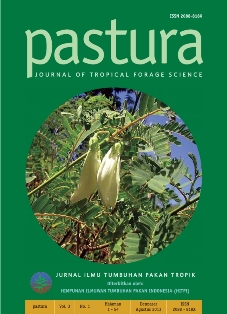PRODUKTIVITAS PADANG PENGGEMBALAAN SABANA TIMOR BARAT
Abstract
The objectives of this study were to evaluate the West Timor savanna productive at different season. The location of this study is in the station of Lili field, Assessment Institute for Agricultural Technology Naibonat Kupang, with 40 hectare of savannah for pasture, held in one year. The data collected are botanical composition, production, feed intake in savannah and forage quality also the carrying capacity. The data analyzed descriptively. The amount of goat used for measurement of feed intake in savannah is 10 does. The result showed that the averages of forage fluctuation available is between 0.61-4,33 ton/hectare. The lowest point of production is happened in the edge of dry season (October) that is 0.61 ton/hectare. Then it increases in early of rainy (December) and reaches the highest point in the early of dry season (April). From this point, then it decreases and reach the lowest point in October, so, the forage production in nature was increases in December. The composition rate of CP is very varied, that is 2.71-9.48%. The composition of CP in nature grass has no significant difference with the composition in other locations of Timor, that is 2.26 % in the ends of dry season and become 8-10% in the rainy. Most of forage on the pasture is nature grass that is upper 90% and relative less of leguminous plants. The lack proportion of leguminous plants in nature savannah result in the less of forage quality, especially during the dry season there is no legume proportion and the quality of nature grass become very low.Downloads
Download data is not yet available.
How to Cite
E. MANU, Arnold.
PRODUKTIVITAS PADANG PENGGEMBALAAN SABANA TIMOR BARAT.
Pastura, [S.l.], v. 3, n. 1, june 2014.
ISSN 2549-8444.
Available at: <https://ojs.unud.ac.id/index.php/pastura/article/view/9052>. Date accessed: 28 nov. 2025.
doi: https://doi.org/10.24843/Pastura.2013.v03.i01.p07.
Issue
Section
Articles
Keywords
production, savannah, pasture, West Timor





